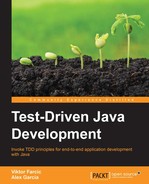Test-driven development has been around for a while and many people have still not adopted it. The reason behind this is that TDD is difficult to master. Even though the theory is very easy to grasp, it takes a lot of practice to become really proficient with it.
Authors of this book have been practicing TDD for years and will try to pass on their experience to you. They are developers and believe that the best way to learn some coding practice is through code and constant practice. This book follows the same philosophy. We'll explain all the TDD concepts through exercises. This will be a journey through the TDD best practices applied to Java development. At the end of it, you will earn a TDD black belt and have one more tool in your software craftsmanship tool belt.
Chapter 1, Why Should I Care for Test-driven Development?, spells out our goal of becoming a Java developer with a TDD black belt. In order to know where we're going, we'll have to discuss and find answers to some questions that will define our voyage.
Chapter 2, Tools, Frameworks, and Environments, will compare and set up all the tools, frameworks and environments that will be used throughout this book. Each of them will be accompanied with code that demonstrates their strengths and weaknesses.
Chapter 3, Red-Green-Refactor – from Failure through Success until Perfection, will help us develop a Tic-Tac-Toe game using the red-green-refactor technique, which is the pillar of TDD. We'll write a test and see it fail; we'll write a code that implements that test, run all the tests and see them succeed, and finally, we'll refactor the code and try to make it better.
Chapter 4, Unit Testing – Focusing on What You Do and Not on What Has Been Done, shows that to demonstrate the power of TDD applied to unit testing, we'll need to develop a Remote Controlled Ship. We'll learn what unit testing really is, how it differs from functional and integration tests, and how it can be combined with test-driven development.
Chapter 5, Design – If It's Not Testable, It's Not Designed Well, will help us develop a Connect4 game without any tests and try to write tests at the end. This will give us insights into the difficulties we are facing when applications are not developed in a way that they can be tested easily.
Chapter 6, Mocking – Removing External Dependencies, shows how TDD is about speed. We want to quickly demonstrate some idea/concept. We'll continue developing our Tic-Tac-Toe game by adding MongoDB as our data storage. None of our tests will actually use MongoDB since all communications to it will be mocked.
Chapter 7, BDD – Working Together with the Whole Team, discusses developing a Book Store application by using the BDD approach. We'll define the acceptance criteria in the BDD format, carry out the implementation of each feature separately, confirm that it is working correctly by running BDD scenarios, and if required, refactor the code to accomplish the desired level of quality.
Chapter 8, Refactoring Legacy Code – Making it Young Again, will help us refactor an existing application. The process will start with creation of test coverage for the existing code and from there on we'll be able to start refactoring until both the tests and the code meet our expectations.
Chapter 9, Feature Toggles – Deploying Partially Done Features to Production, will show us how to develop a Fibonacci calculator and use feature toggles to hide functionalities that are not fully finished or that, for business reasons, should not yet be available to our users.
Chapter 10, Putting It All Together, will walk you through all the TDD best practices in detail and refresh the knowledge and experience you gained throughout this book.
